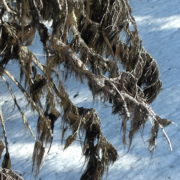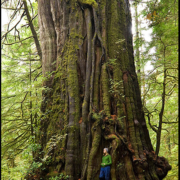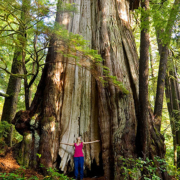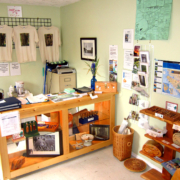PORT RENFREW — Rosie Betsworth and TJ Watt readily admit the irony of their relationship and acknowledge it is raising eyebrows among old-timers in Port Renfrew.
But, recognizing the old saying that necessity makes strange bedfellows, Betsworth, president of Port Renfrew Chamber of Commerce, believes the liaison with the Ancient Forest Alliance is positive for everyone mapping a new future for the former logging town.
“We used to depend on logging to sustain Port Renfrew. Now the tables have turned and we’re looking at the tall trees as our future,” said Betsworth as the two groups cemented their partnership Thursday with the opening of a new tourist information centre, where visitors can pick up a map of the area’s massive old-growth trees.
“Some of the older folks from the logging industry have other opinions and that’s fair. This community did survive by logging in the past, but they have to understand this is a new world. This will sustain our town,” Betsworth said.
The Chamber would never ally itself with a radical environmental group, but the AFA educates people about the forest and benefits of protecting old growth, Betsworth said.
“Their approach is soft and it works,” she said.
International visitors have been coming to the tiny west coast community of 270 people since news spread about a stand of massive trees dubbed Avatar Grove.
The Red Creek fir, the world’s largest Douglas fir, and San Juan spruce, Canada’s largest Sitka spruce are also in the area.
The AFA takes monthly tours to Avatar Grove, with between 30 and 80 people on each tour and vehicles are parked daily on the remote logging road as tourists struggle into the unforgiving old-growth terrain to look at gnarly giants.
Each of those visitors is likely to eat a meal or stay the night, Betsworth said.
“It’s a big economic driver.”
Watt, who has escorted thousands of visitors up and down the steep, slippery slopes of Avatar Grove, believes Port Renfrew’s future lies in nature.
“It has all the makings of an incredible destination — wildlife, rivers, lakes, beaches, big trees, fishing and surfing,” he said, looking at the “world’s gnarliest tree,” a red cedar, stretching up about 80 metres with a bulbous, three-metre burl and serpent-like roots.
Rough paths now run through the forest and pink tape indicates navigable routes through the green maze of rainforest, which produces giant mosquitoes as well as giant trees.
But much of the grove remains unprotected and the Teal-Jones Group has cutting rights.
“It would be such a smart choice to protect this area, such a great opportunity,” Watt said, musing about the public outcry if logging started in the grove.
The province is exploring protecting the whole stand through an old-growth management area, meaning no cutting would be allowed, and stakeholders are being consulted, Forests Ministry spokeswoman Vivian Thomas confirmed.
A section is already in an old-growth management area.
The prospect of an eco-tourism based economy, helped by the paving of the logging road from Port Renfrew to Lake Cowichan to form the Pacific Rim Circle Route, is taking root throughout the community.
Close to the tourist information centre, flatbed trucks are delivering pre-fabricated cabins to Three Point Properties’ Wild Coast Cottages development.
The 35 square-metre cottages, surrounded by innovative landscaping on 230 square-metre lots, sell for $129,000 to $159,000. Thirty-one out of 40 have sold since last June.
The second, waterfront phase, with 40 bigger, more expensive cottages, will be launched in a couple of weeks, said sales manager Nancy Paine.
“I have noticed the change in Port Renfrew in the last year,” she said.
“Lots of young people are becoming involved. It was once a forestry town — that’s why people lived here — and now it’s being promoted as the quintessential West Coast experience.”
A possible sign of Port Renfrew’s transformation is that the community now has what Betsworth describes as its first strip mall — four small businesses beside the West Coast Road.
There is still the weather factor, she acknowledged as a fine drizzle fell.
“But look how green everything is here. It’s a tradeoff. It’s a good lifestyle and you take the rain with the sun.”
Times Colonist article not currently available.






